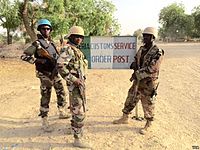
A | B | C | D | E | F | G | H | CH | I | J | K | L | M | N | O | P | Q | R | S | T | U | V | W | X | Y | Z | 0 | 1 | 2 | 3 | 4 | 5 | 6 | 7 | 8 | 9
| Boko Haram insurgency | |||||||
|---|---|---|---|---|---|---|---|
| Part of religious violence in Nigeria, War against the Islamic State, Islamist insurgency in the Sahel, and the War on terror[52] | |||||||
Niger Army soldiers during an operation against Boko Haram in March 2015 (top) Nigerian CJTF militiamen in 2015 (bottom) | |||||||
| |||||||
| Belligerents | |||||||
|
Multinational Joint Task Force Local militias and vigilantes[5] |
| ||||||
| Commanders and leaders | |||||||
|
Boko Haram: ISWAP: | |||||||
| Strength | |||||||
|
Nigerian Army: 20,000 active personnel 300 U.S. advisers[30][31] Militias and vigilantes: Unknown, several tens of thousands[63] | Fluctuating; thousands to tens of thousands on average[c] | ||||||
| Casualties and losses | |||||||
| Unknown |
Thousands killed, captured, or surrendered [69][70][71][72][73][74] | ||||||
|
350,000 deaths total, of which 35,000 direct[75] 2,400,000 internally displaced[76][77][78] | |||||||
The Boko Haram insurgency began in July 2009,[79][80] when the militant Islamist and jihadist rebel group Boko Haram started an armed rebellion against the government of Nigeria.[54][81] The conflict is taking place within the context of long-standing issues of religious violence between Nigeria's Muslim and Christian communities, and the insurgents' ultimate aim is to establish an Islamic state in the region.[82]
Boko Haram's initial uprising failed, and its leader Mohammed Yusuf was killed by the Nigerian government.[83] He began the group in the year 2002, with a view of opposing western education with his followers.[84] The movement consequently fractured into autonomous groups and started an insurgency, though rebel commander Abubakar Shekau managed to achieve a kind of primacy among the insurgents. Though challenged by internal rivals, such as Abu Usmatul al-Ansari's Salafist conservative faction and the Ansaru faction, Shekau became the insurgency's de facto leader and mostly kept the different Boko Haram factions from fighting each other, instead focusing on overthrowing the Nigerian government.[85] Supported by other jihadist organizations including al-Qaeda and al-Shabaab, Shekau's tactics were marked by extreme brutality and explicit targeting of civilians.[84]
After years of fighting, the insurgents became increasingly aggressive and began to seize large areas in northeastern Nigeria. The violence escalated dramatically in 2014 with 10,849 deaths, while Boko Haram drastically expanded its territories.[86][87][88][89] At the same time, the insurgency spread to neighboring Cameroon, Chad, Mali, and Niger, thus becoming a major regional conflict in Sub-Saharan Africa.[52][54][90] Meanwhile, Shekau attempted to improve his international standing among jihadists by tacitly aligning with the Islamic State of Iraq and the Levant in March 2015, with Boko Haram becoming the "Islamic State's West Africa Province" (ISWAP).[52]
The insurgents were driven back during the 2015 West African offensive by a Nigeria-led coalition of African and Western countries, forcing the Islamists to retreat into Sambisa Forest and bases at Lake Chad.[citation needed] Discontent about various issues consequently grew among Boko Haram. Dissidents among the movement allied themselves with IS' central command and challenged Shekau's leadership, resulting in a violent split of the insurgents. Since then, Shekau and his group are generally referred to as "Boko Haram", whereas the dissidents continued to operate as ISWAP under Abu Musab al-Barnawi. The two factions consequently fought against each other while waging insurgencies against the local governments. After a period of reversals, Boko Haram and ISWAP launched new offensives in 2018 and 2019, again growing in strength.[91]
When Boko Haram's insurgency was at its peak in the mid-2010s, it was the world's deadliest terrorist organization in terms of the number of people it killed.[92][93][94] In a bid to ensure dialog between government and the deadly sect, the President Jonathan administration set up a committee to grant an amnesty to Boko Haram.[95][96] Some details of the amnesty includes granting of pardons to Boko Haram fighters and also listening to different ethnic groups under the sect with a bid to ending violence. This amnesty was rejected by the sect in an audio broadcast that was sent by its leader on the grounds that they are fighting to create an Islamic state in Nigeria's predominantly Muslim north and that it is the government that is committing atrocities against Muslims.[97]
In May 2021, ISWAP attacked and overran Boko Haram militants in the Sambisa Forest and the leader of Boko Haram Shekau was killed during the fighting, reportedly using a suicide vest.[98] In August, Abu Musab al-Barnawi, the leading commander of ISWAP, was killed.[99] After Shekau's death masses of Boko Haram militants surrendered while others defected to ISWAP. According to the Nigerian Defence Forces, as of April 5, 2022, a total of 51,114 rebels and families, consisting of 11,398 men, 15,381 women, and 24,335 children, have surrendered. This number has risen to over 100,000 in July 2023.[100] A commander of the Joint Task Force expressed optimism that the Boko Haram crisis would end very soon, while advising the troops not to rest or give the terrorists a chance to recuperate, reorganise and start carrying out attacks, saying, “We are almost there, so let’s maintain the momentum.”[101]
Background
| Part of a series on |
| Jihadism |
|---|


